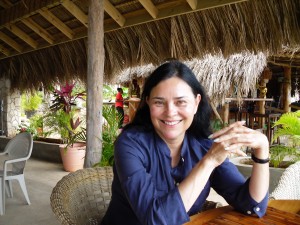
Let me be clear about this: I didn’t even see the naked man when I took a picture of him.
“Did you just take a picture of that naked man?!?” my husband said, startled.
“What naked man?” said I, more startled still.
“That one,” he said, pointing over my shoulder at the shore. Sure enough.
I _had_ been taking a picture of the picturesquely-thatched boat-rental place from which we’d just departed, embarked upon a cruise up Jamaica’s Black River (so called, according to the guide, because of a thick layer of decomposing peat moss at the bottom; the water is clear, he said—the bottom is black. It also releases methane gas as it decomposes, which is temporarily trapped under the water. When this gas bubbles suddenly up, it’s often ignited by lightning, which (the guide said) “burns down the whole swamp several times a year.” I don’t suppose the crocodiles care, one way or the other, but it must be a nuisance to the people who live next to it).
However, right next to the boat-rental place was a short break in the shoreline, before the bulrushes and mangroves began. In this break was a small shed of some kind, a boat pulled up on shore, and…a naked man. I don’t know whether he had just been pushing his boat up on land, swimming, or possibly doing his laundry, but there he was. A very nice-looking man, too, very tall and muscular, fairly young, and quite well–, um. Let us just say that Lord John would have admired him exceedingly.
I didn’t see him at all when I took the picture, and wasn’t sure he was actually in the photograph, until I had a chance to look at it later. He certainly contributed a lot to the conversation over dinner that night, though.
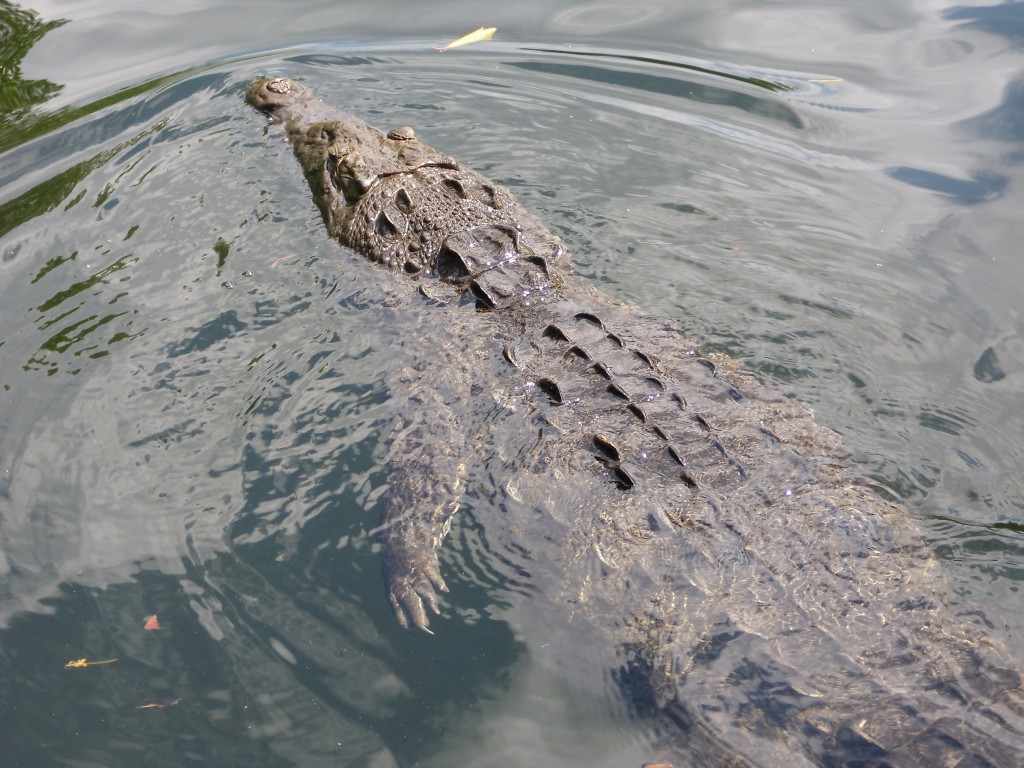
The Black River (with all its interesting flora and {cough} fauna) was the first stop on a day of adventure. The Black River Safari, as they call it, is pretty much like Disneyland’s Jungle Boat ride, only with real crocodiles. (Well, no head-hunters or giant pythons, either, but you can’t have everything.) And the guides don’t fire toy pistols at the reptiles; they sidle up, cut the motor, and lure the crocodiles closer with handfuls of raw chicken (all the while assuring you that they don’t give the crocodiles so much that they’ll give up hunting. Not so sure about that; the crocodiles have names (that’s Josephine up above and—I think—George below) and plainly know that when a boat pulls up alongside their basking spot, lunch is served.)
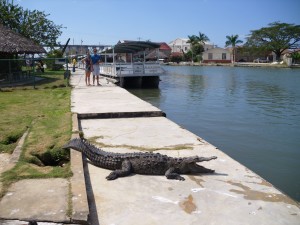
It may have had to do with the time of year, but there was surprisingly little bird-life on the river. We saw a Little Blue Heron and a few egrets (though we were informed that come nightfall, there would be something like 40,000 egrets roosting in the mangroves along the river), but that’s about it. Did see one heck of a lot of mangroves, though—a few shots of which I include, not merely out of scenic interest, but as reference to the part of VOYAGER in which Claire comes ashore in a mangrove swamp.
This is the sort of thing she would have been faced with—though fortunately she encountered only four-eyed fish (and the odd Jewish natural philosopher), and not crocodiles.
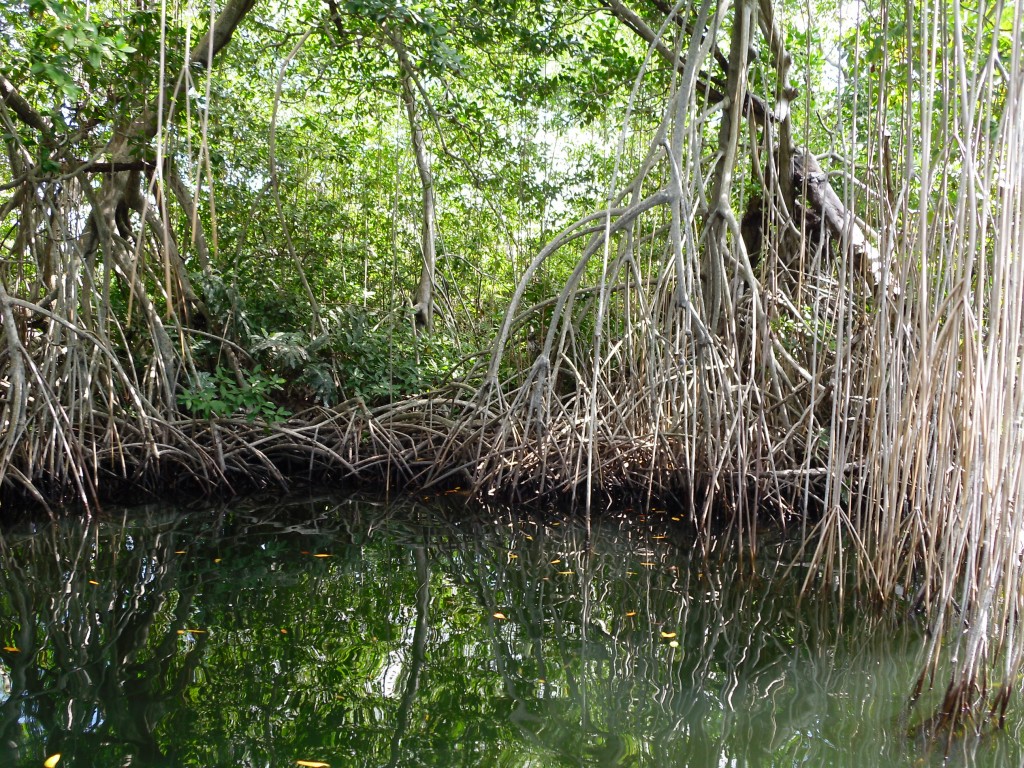
Yes, there are a lot of crocodiles in the Black River. Also (they said) tarpon that get up to 250 pounds, because they don’t taste good, so people don’t fish for them. However (they said), tarpon don’t bother people (I don’t care; I don’t want to meet anything in dark water that weighs 250 pounds, up to and including Hulk Hogan), and crocodiles require warmth to digest their food, so are not dangerous during the day (like anybody’s going swimming in something called the Black River at night? Riiiiiiight….).
Owing to the fact that Jamaica has very few road signs, you really need a driver if you’re going to go sight-seeing and not end up in the Great Morass (this being pretty much what it sounds like: a very deep, narrow valley full of jungle and sugar-cane fields, edged by a narrow, twisty road). We had the great good fortune to have a driver named Tony, who’s been working for the Tensing Pen resort (the lovely place where we were staying) for thirty years, and not only knew where we were going, but where one could conveniently stop to go to the bathroom along the way (a tiny convenience store in Whitehouse, where I encountered one of the 75% of non-working Jamaican toilets), and where to find a quick lunch (“Juici Patties,” this being a fast-food establishment specializing in patties—these being a staple of Jamaican cuisine, resembling empanadas or turnovers, filled with cheese, beef, chicken or lobster, often curried. These were excellent—the ambiance of the place also enhanced by a decrepit car in the parking lot with giant speakers (ancient, but in good operating condition) wired to the roof, which blasted out, “I WANNA BE A BILLIONAIRE SO FUCKIN’ BAAAD” at a thousand decibels or so just as I emerged from our car next to them), and notes on the passing roadside scene (every town had a roadside market, consisting of a few dozen tiny stalls stocking the local specialties. Whitehouse, Tony said, is where most of the fish came in—cooks from the resorts would get up at 3 AM and drive to Whitehouse to get lobsters and fish from the boats coming in at dawn. “That’s a good kingfish,” he noted approvingly, as we passed a woman sitting on a box, filleting knife in hand, the kingfish in question lying invitingly on her lap).
It’s a good long drive from Negril, where the resort is, to the Black River, so we saw a good bit of roadside Jamaica, including innumerable tiny eating-places. There are (of course) a few regular restaurants, both stand-alone and associated with resorts, but there are thousands—really, thousands–of tiny shacks with a picnic table or two, selling the ubiquitous jerk chicken, brown stew, conch salad and Red Stripe Beer. Especially along the sea-coast, anyone with a foothold of even a few feet on the shore has a table and a grill.
As we got higher into the mountains, the food changed somewhat, and we began to see clusters of what Tony called “shrimp-ladies” along the road; women who fish the river for crawfish, boil them with spices (they’re called “hot pepper-shrimp”), then sit by the road holding buckets and cardboard cones of these crustaceans to sell to passersby. While normally up for sampling the local delicacies (I have, on occasion, eaten both sea-urchin and jellyfish—the latter being a lot like eating fried rubber-bands, the former being mushy but tasty), we passed on the crawfish, being a) not hungry, and b) eager to get on, as the Black River was only the first adventure of the day.
Next up was the YS Falls:
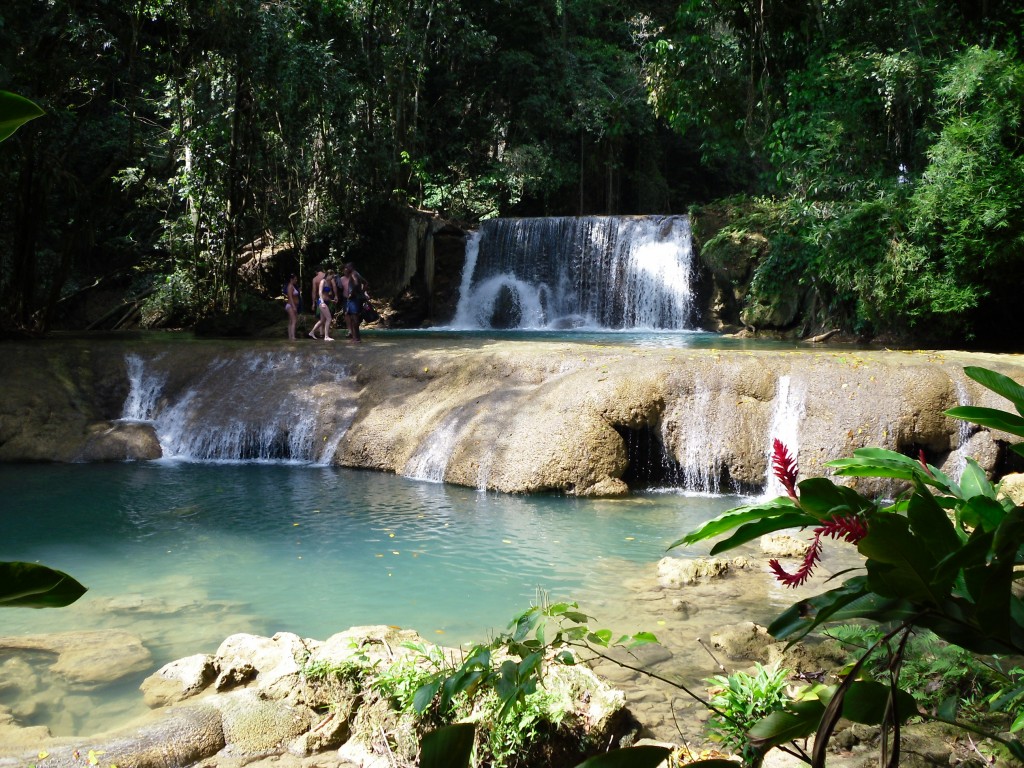
They’re called the YS Falls because they occur in the YS River—but nobody knows why the river is called that, though one supposition is that it’s from the Gaelic “wyes” meaning “twisty or winding”. (There were a good many Gaelic-speaking Scots on Jamaica back in the 18th-century, some having been transported as convict labor, others working as overseers on plantations.)
You pay admission at an office, and are loaded into a jitney—this being an aged tractor, hitched to a flatbed trailer equipped with bench seats and a roof for shade—and are trundled up a road that winds along beside the river, through a number of beautiful fields full of Red Polled cattle (we asked what kind of cattle they were, having not seen that variety before. My late father-in-law, Max, was a cattle-man, and wherever we went with him, cows were a magnet. He could find cows anywhere, and in consequence, we always notice them when we travel).
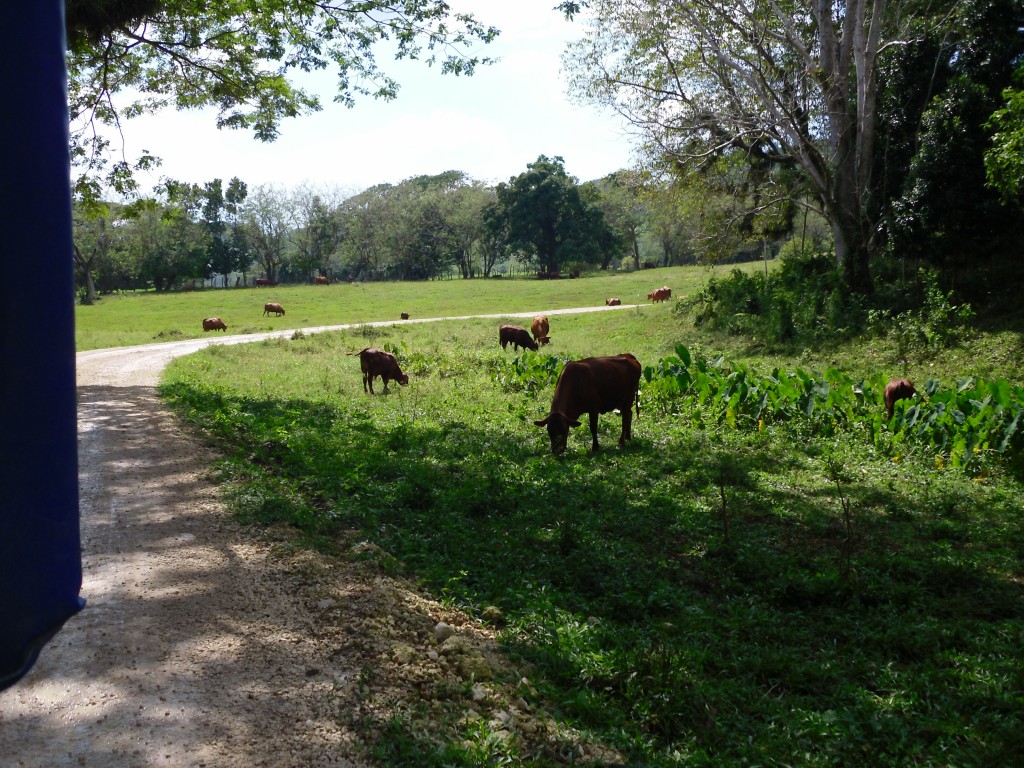
In addition to the Falls, there’s a zipline concession. Don’t know if you’ve ever seen a zipline close up—I hadn’t. The theory is that the punters assume protective clothing (padded jacket and helmet) in case of collision with trees, are attached via a sort of pulley to a heavy-duty clothesline running from some high point through the jungle to a lower point, and are then pushed off a platform, to go hurtling through space.
No, we didn’t. {g} My sense of adventure has its limits. Did enjoy watching the fauna at the Falls, though (it has three limpid pools, suitable for swimming), including the Very Large Gentleman in the Very Small Speedo, the Ladies Who Forgot to Put Sunscreen on Their Backs, and the occasional shrieking zipliner hurtling past overhead.
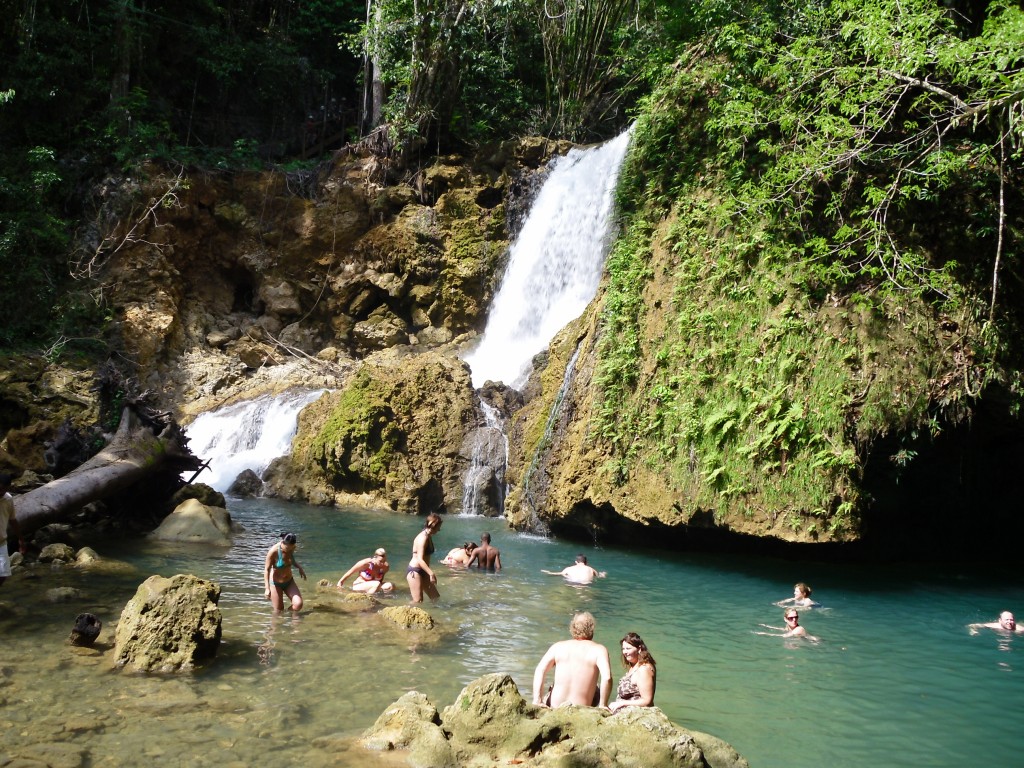
We didn’t stay long at the Falls. Shared an extremely good Haagen-Daaz) ice-cream bar (it was a warm day), then on to the final stop of the day—the Appleton Estate Rum Tour.
Now, I don’t expect that Lord John will be ziplining during his tour of duty as Governor of Jamaica, but I was pleased to find that the Appleton Estate has been making rum on Jamaica since 1749, and thus would certainly have been in a position to present His Excellency with a cask or two. (As in, you bet it’s research!)
The Rum Tour begins (reasonably enough) at the public bar, where you’re presented with a complimentary cup of Rum Punch (and very good it is, too. The recipe is proprietary, but a tasting strongly suggests that it’s a mix of cider and orange juice, rum added to taste), before being taken through the grounds by a guide.
Said grounds are strewn with antique rum-distilling equipment—including a few working pieces, like the early 19th-century sugar-cane mill, driven by a donkey named Paz (“peace”). We got to taste raw sugar-cane juice, and also the “muscado”—the result of boiling sugar-cane juice in huge iron vats: a mixture of thick, aromatic molasses and grainy brown sugar. Delicious!
Actually, both the process and the machinery for making rum are much like those for making whisky, once you reach the fermentation stage. I.e., the goo (whether muscado or mash) is fermented for a period of time, then put through the distillation process that removes the alcohol, which is then casked and aged.
After touring the fermentation and distilling facilities (and seeing raw rum being siphoned into a tank truck for transport to another, larger aging facility), we viewed the oldest aging building, containing some eight thousand casks—and then the guide turned to us, beaming, and said, “Now…we get drunk!”
Next stop was a tiny private bar, on which all the Appleton rum products were lined up (a dozen or so, from ten-year-old rum to CocoMania (a coconut-flavored rum liqueur, and very good, too) to Rum Cream Liqueur and something called “overproof rum,” which is essentially rotgut (i.e., unaged, raw rum, very alcoholic). Dozens of tiny plastic tasting cups were provided, and we were invited to taste as much as we liked of anything. So we did—then went across to the shop and bought a bottle of the ten-year-old rum (research) and one of CocoMania (this being a present for our host and hostess at the resort). Then we went back to the public bar for another Rum Punch, before rolling out to find Tony and make our way back to Negril through the late afternoon.
All the school-kids were coming out, all dressed in tidy uniforms, and the shrimp-ladies had sold their stock and disappeared, as had most of the market stall-holders. The small towns, like Maggoty, are for the most part collections of small stucco buildings, with a few of the tin-roofed wooden houses like those you see on the coast—most of them painted in gum-drop colors, fading into one another in the late afternoon light and looking like half-ripe fruit amid the surrounding jungle.
The jungle was doing a bit more than surrounding, for that matter—it was quietly reclaiming anything left alone for more than a week or two. All along the way, you could see houses, cars—once a school bus, its front wheels already sunk into the earth—silently melting back into the jungle. The small farmers wage a constant battle to keep their fields and houses from simply being swallowed up.
(Not that I want to Start Anything here, but the people who keep carrying on about how people are Destroying the Planet do not, I think, have a real good idea of just how powerful said planet is. People can certainly destroy themselves, yes, and a few other species along the way, but the planet? Ha.)
One final note on the journey home: One of the small hamlets up there in the mountains is called Accompong. This was the name of the maroon leader of one of Jamaica’s slave rebellions (there were five, during the 17th and 18th centuries). This was pretty interesting to me, as I’d used that gentleman in “Lord John and the Plague of Zombies” (which, I’ve just been told, will be published this October (!) in an anthology titled DOWN THESE STRANGE STREETS), and was pleased to see this memorial to him. I also used those mountains in the story, and was more than impressed at the effort it must have taken to get up there on foot, through the jungle.
(Speaking of “foot”….our hostess at Tensing Pen told us that their American guests occasionally go jogging up the road, to the amazement of the Jamaicans along the way, who call out, “What the fuck you runnin’ for, mon? Who’s chasin’ you?” Which rather neatly sums up the cultural differences there.)
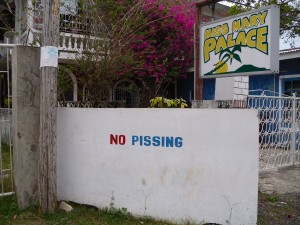
[No, I’m not posting a picture of the naked man (he did turn out to be in the background of the picture I’d taken, and while not really obvious, was definitely still naked. When I enlarged the picture somewhat, it was also obvious that he’d seen me pointing a camera in his direction; he had his face turned away, arm outflung, and clearly had no intent of auditioning for a NatGeo special on Jamaica. So even though I didn’t photograph him on purpose, it really wouldn’t do to compromise the poor man’s privacy further.]
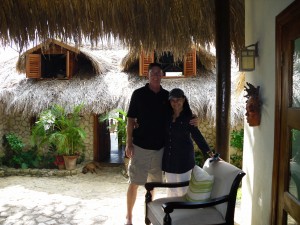
Wow!
Thanks for sharing yet another adventure with us! I wish you could share some of that sunshine… the Bershire’s are frigid.
PS: ave you had the opportunity to try out your Shepherd’s Watch? It was one of my favorite conversational pieces of jewelry!
Dear Meghan–
I have, and thank you so much! (Btw, should you ever want it back, just say so–I feel badly, taking it from you.)
–Diana
Diana,
You are an inspirational writer. I contemplated giving you that for weeks and am so glad I did. I’m sure you are given many things and am just thrilled that it has been put to use by you, someone who understands the concept of Time! It was a possession with meaning and I believe you understand that meaning more than most.
I’m glad you are enjoying your life and am looking forward to your next book BUT take you TIME… you have a lot to live up to
No pressure just encouragement!
- Meghan
Loved reading your story of the adventures you are having. I am going to Jamacia for the first time in March (27) and can’t wait to go and see the white witch house . Will you be going on that tour. Wish you would still be there in March would love to meet you. Just reading this makes me wish for Jamie.
Dear Diana,
Taking such photos of men could be considered research IMO. Someday they might make a mini series or movie out of the most awesome Outlander series and this research could be used to make sure Jamie is cast right.
Take Care, Cynthia
Glad you and husband had such a great time! Thanks for sharing the pics and the stories. Taking the “oops” pic of the naked man, well that sounds like something I would do. And my husband would indeed be very helpful about pointing it out.
I guess your previous knee surgery did not interfere with you getting around the rough terrain.
Enjoy your writing as always!
Thank you for sharing your trip & photos… they are lovely (and you are very photogenic). Like others, I was searching for the photo with the naked man, but I guess I’ll just have to use my imagination.
Diane, I have just been introduced to your writing and I am starting Dragonfly today. I have collected alot of your books so I have to hurry up and enjoy them:)
I really enjoyed this post. I was married in Jamaica and stayed in Kingston and Ocho Rios. My husband had been principal of a school in MaiPen and we visited there. I want to go back and see the house where Elizabeth Barret Browning’s family lived. I also would love to see the house where the widow lived that poisoned her husbands – there was lots of talk about her. I really enjoyed your pictures of the falls. Unfortunately, it rained the day we went there and so didn’t get to tour.
Dear Susan–
It was my first–and so far, only–trip to Jamaica. Hope to go back again sometime, though!
–Diana